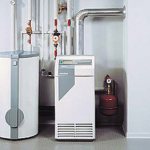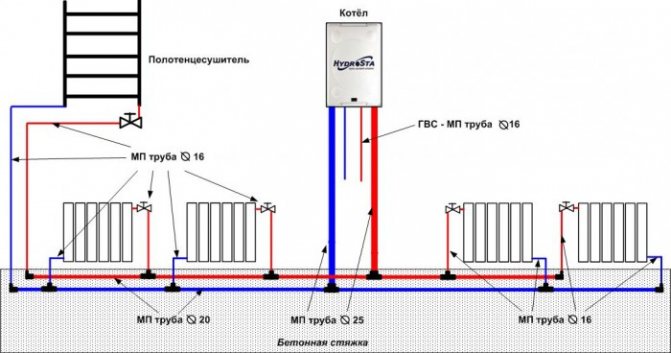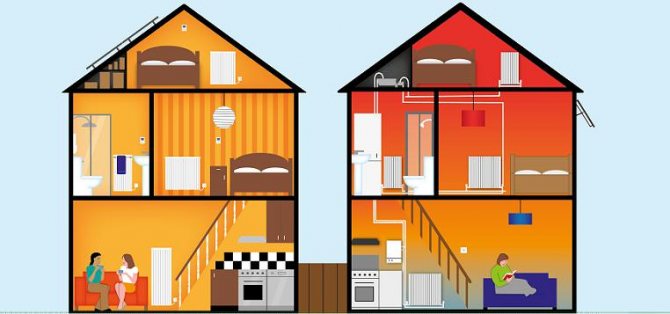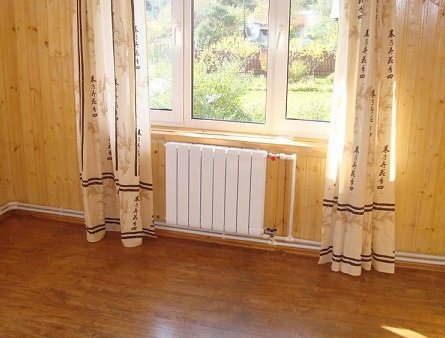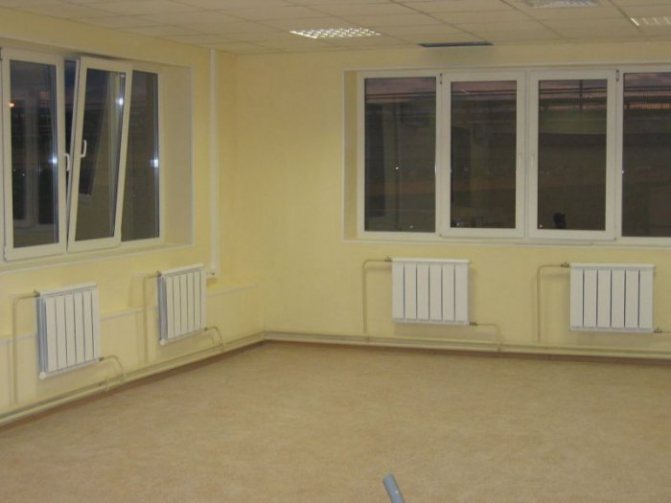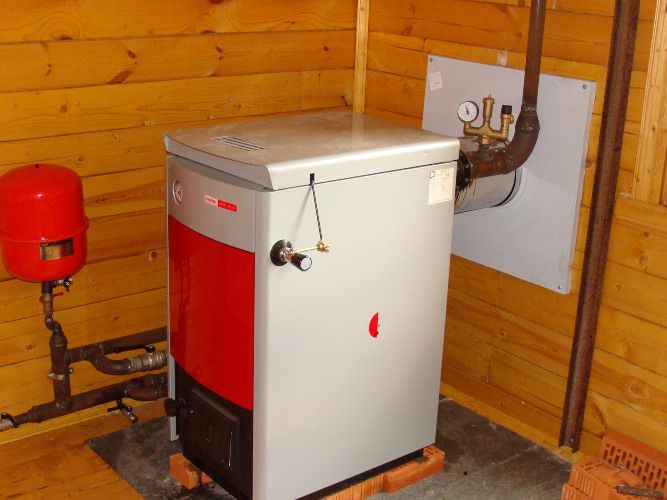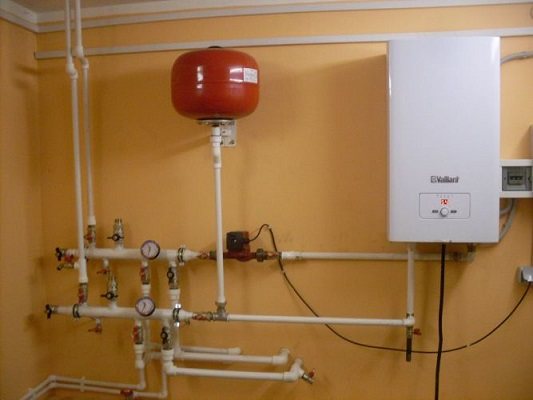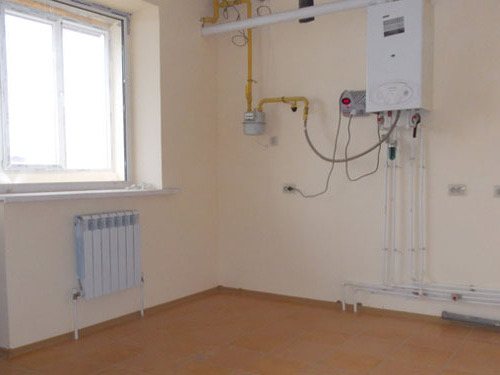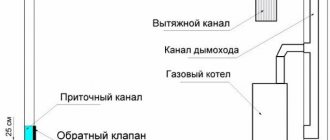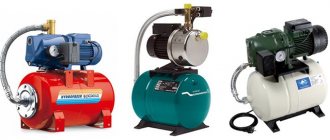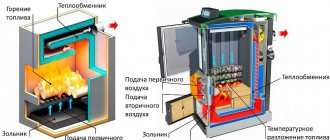Advantages and disadvantages
Dignity
Let's take a closer look at the second option and define its positive and negative aspects. To begin with, let's figure out what an autonomous heating point is. This is a separate room where boiler equipment is located, the power of which is sufficient to provide heat and hot water to the entire apartment building. This is a kind of mini-boiler room with a full range of necessary devices, fixtures and systems. Modern technologies for providing heat to residential buildings began to be used precisely in autonomous systems. The latter worked for one or more houses, which was doubly profitable. Why?
- Firstly, the distance from the heat generator to the heating devices in each apartment has been significantly reduced. This means that the heat loss has decreased due to the transportation of the coolant.
- Secondly, the time for supplying heat to the consumer was reduced, which, again, is associated with a decrease in the distance.
- Thirdly, the costs of maintenance of heating networks, their repair and installation have changed to a lesser extent.
- Fourth, the economic performance resulting from the previous benefits has declined. This means that the cost of the supplied coolant has changed to a minimum.
Autonomous system diagram
There is one more advantage of the system. When a house is being built, the developer is required to obtain a large number of permits that will allow him to crash into the central highway. The bureaucratic delays sometimes take months. And the installation of a metering device will cause a lot of disputes between developers and the host, that is, the operating company. So for builders, option c, even for the largest house, is ideal.
And the last advantage - the boiler room for the microdistrict occupies a place where not only buildings and water tanks will be erected, but also an electrical substation, access roads, warehouses, office premises, administrative buildings, etc. That is, a fairly impressive site will have to be allocated for it. And if there is no need for a boiler room, the district administration can use this area for its own needs. For example, to build another residential building, school, clinic, etc.
disadvantages
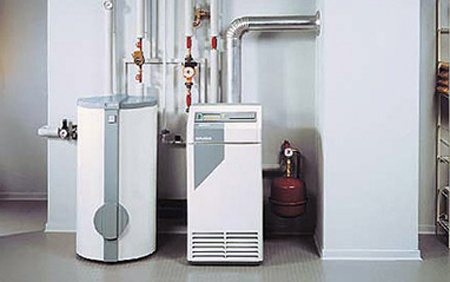
Gas boilers
Cons exist in any system, but there are usually fewer of them:
- An autonomous boiler room should be located in a separate building, therefore, it is necessary to allocate a site for it near the house. Sometimes such a building looks like an extension.
- Mini-boilers pollute the environment to a certain extent. Therefore, modern cleaning devices are indispensable here. And being inside micro-districts obliges to create conditions for environmentally friendly performance indicators. They exist and are stipulated by the norms and rules of SNiP. Hence the rise in the cost of the equipment itself.
- An autonomous heating system is not yet as popular as a centralized one, therefore the production of equipment and related components has not yet been put on stream. Hence the high cost of such systems. This means that not all developers can afford them.


Heating regulator
However, experts say that engineering developments today can eliminate some of the shortcomings. For example, if an autonomous boiler room is used to heat only one apartment building, its equipment can be placed in the attic - the dimensions of the devices allow this.In addition, the attic immediately becomes heated, which is undoubtedly a plus. In addition, the area between the houses is freed up. The only requirement for such options is a flat roof, which is not a problem. If you plan to install just such a heating system, then you can add a flat roof to the project. Experts have already carried out preliminary calculations, which have shown that even if the cost of equipment and installation costs are high, all this will pay off in several seasons.
Paperwork and its difficulties
If usually the sum of money for the service acts as a catalyst for all problems, then in the case of autonomous heating it is the collection of all the necessary confirmations and permits for installation.
In addition, permits may not be obtained at all, since officials are very reluctant to meet halfway and may simply stall the issue, especially if the apartment in the house is the only one claiming heating independence. If a refusal occurs, then it is imperative to convene a commission, which, with the support of independent experts, will have to justify the decision of the utilities and make a final verdict.
On the other hand, if the house is not an apartment building, but its own, then the problems become much less. This is due to the fact that you can simply contact the installation company, which will deal with all problems: from obtaining the necessary documents to installing the boiler.
Gas roof boiler room
The device has the following positive aspects:
- High efficiency. Fuel consumption is reduced by using LPG, which releases energy when heated.
- There are almost no external communications. This reduces the cost of funds. Heat loss is also reduced.
- In low-rise buildings (up to 26 m), there are no additional installation requirements, which reduces the cost of the project.
- Automation, which reduces the cost of operation.
- The appliance is not shut down for annual inspection, which allows daily use of hot water.
The device has several limitations. To accommodate the boiler room, the roof is strengthened by installing a concrete cushion. The load that the building can withstand is calculated in advance.
For installation, they bring special equipment, the work of which creates inconvenience to the residents. The cost is also unpleasant: the costs go to the creation of the project, the laying of the gas carrier, the automation responsible for the control. Additionally, protective measures and a fire extinguishing system are installed.
Benefits of Autonomous Systems
Autonomous heat supply of an apartment building has many advantages to its owners:
- The heat supply of an apartment building is almost completely automated, therefore you can set a certain temperature mode and it will be observed by the device. In addition, it will be possible to set the minimum temperature parameters in case of departure, so that excess heat will not go into the void.
- Autonomy allows you to depend only on yourself, because constant pipe breaks from utility companies will no longer turn off the heating. While many will wait for the return of heating, the owner of the autonomous heating in the apartment can calmly bask in his apartment.
- The devices undergo a technical check, therefore breakdowns are extremely rare and you can fully rely on the heating system and not be afraid of turning off the heat supply at the most inopportune moment.
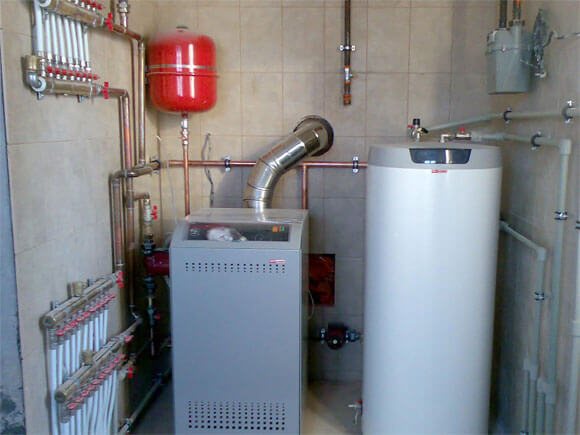

Advantages of gas boilers
Gas boilers widespread, since they are practical and easy to use, they are distinguished by moderate prices for equipment and for the process of further operation.
Autonomy


Devices are called autonomous or independent, not requiring permanent connection to general communications.
If you drill a well and make a volumetric reservoir, then in plan water supply the house will be considered autonomous, since it does not depend on a centralized water supply. A similar system works for a gas boiler.
If the gas pipeline does not pass nearby, and to heat with wood and coal there is no desire, then the installation of a boiler working on natural or liquefied gas, will greatly simplify and reduce the cost of heating the house.
Reference. Autonomy is achieved due to the fact that the gas is in cylinders... Therefore, his can be transported anywhere. It is enough to allocate a small space for the cylinders, connect them to the system.
Minus cylinders - their rapid devastation... In this case, either mobile gas tank, or stationary, which holds a much larger amount of gas and is able to heat the house longer.
High efficiency
The average efficiency of a properly operating gas boiler is more than 90%... It all depends on the type of fuel, type of device, ambient temperature and other factors.
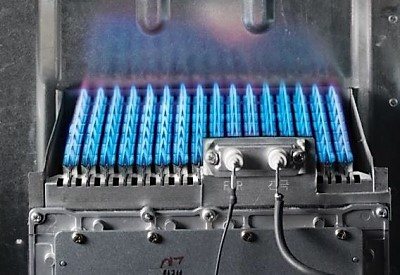

Some units have significantly higher efficiency - about 95%, others - slightly lower... Therefore, the figure in 90%.
This value anyway higherthan boilers solid fuel... Gas combustion leaves minimum amount of "waste"but they are transferred to the atmosphere as carbon.
And if we add to this factor low fuel pricethen the gas boiler becomes an economically viable heating device.
Long term of work
Boiler lifetime depends on several factors:
- From prices.
It is logical to assume that cheap the unit is unlikely to serve long enough, because during its production money was saved on equipment, on security systems, on the quality of the material. The average service life of an inexpensive boiler is about 10-15 years, while qualitative the device is able to work 20-25 years.
- From correct operation.


If there are power outages in the apartment or house, then it is better to purchase uninterruptible power supply system on-line.
It rectifies the incoming current and does not allow voltage surgesinstantly switching to your own resources. This precaution will save the most expensive part of the boiler is its electronics, the price of which may be from one third to half of the cost the boiler itself.
- From fuel quality.
At first glance, it may seem that the gas is not diluted. In fact, like diesel and gasoline, gas can also be far from superior quality. Therefore it is worth buy it only from trusted suppliers.
All these measures will maximize the life of the boiler.
Compactness
Gas boiler does not require large rooms for its location. The size of the device can be slightly larger than a washing machine... This makes it possible to attach the unit to almost any place: in the bathroom, toilet, corridor, storeroom, boiler room (if available). Even a small apartment can accommodate a gas boiler, which will be an additional source of heating.
Lack of storage space can be called a positive point only if the living space connected to the main gas pipeline system.
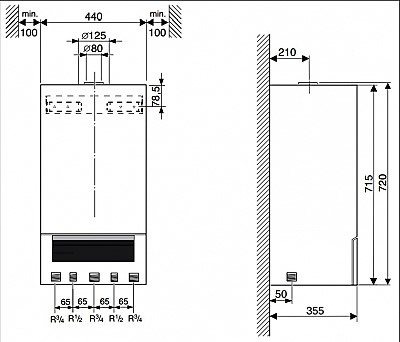

For full operation, such a boiler requires only connection to the gas pipe.
On the other hand, autonomous gas devices imply the need to organize space for cylinders or gas holder.
If this causes inconvenience to the apartment owners, then in a private house you can find a place for the device or create it. In this regard, it is much more convenient to have stationary gas holder.
He buried in the ground and does not formally require any place in the house or on the street, but due to the large volume it is filled once a year... With moderate gas consumption and an insulated house, the gas tank will last for a long time.
Ease of operation
It will not be difficult for an adult to understand the basic functions of the boiler, to find on and off buttons, and valve for gas supply. The system is assembled in such a way that it was easy for its owners to perform the necessary manipulations.
Electric heating systems
Today, electrical equipment for decentralized heating is considered the most economical. In the operation of such devices, as a rule, the principle of water polarization under the influence of alternating current is used.
Connecting one apartment assumes a simple autonomous system with the installation of an electric boiler with an anode principle of operation. The use of double-circuit systems implies the possibility of arranging underfloor heating through a separate circuit. For small-sized rooms, the best option would be special batteries with individual heating, which allow you to independently regulate the heat indicators.
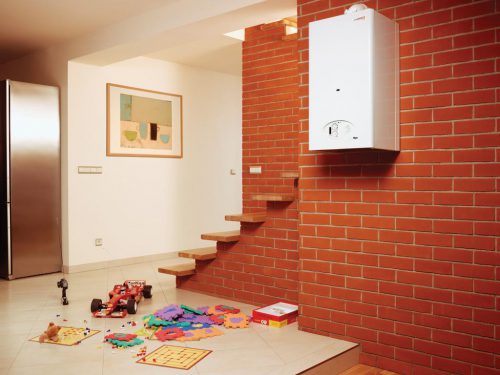

A more complex process is the transfer of an entire residential building to an autonomous electrical system. To do this, initially it is necessary to resolve issues with the substation, calculate the expected load on the power grid in accordance with the power of the transformer. Switchgears should be replaced if necessary. This event must be coordinated with the energy company.
Important! Most older systems and wiring will not be able to handle high loads. Therefore, in a house converted to autonomous heating, it is recommended to replace incandescent lamps with LED sources, as well as to reduce other electricity costs.
How did you manage to minimize the consequences of a domestic gas explosion so much? Proceeding from the fact that the presence of a gas pipe in the house is a potential source of danger, Stroykorporatsia, when designing its real estate objects, did everything possible to minimize such risks. For example, gas boilers installed in each apartment and providing residents with heat and hot water are not chosen on the basis of cost reduction, but on the basis of common sense and the desire to ensure maximum safety and energy efficiency.
Italian gas boilers BAXI are economical and functional, they use gas very economically and work even at a pressure of 5 bar.
All models have a digital control panel on which you can set the operating mode of the boiler, the temperature of the water in the heating system and hot water supply, and set the underfloor heating mode. Depending on the model, it is possible to regulate the operation of the boiler in accordance with the weather outside the window by connecting a special outdoor temperature sensor. Also, BAXI boilers are equipped with protection against pump blocking and thermostat overheating, are able to maintain a constant temperature in the heating system without surges and interruptions, and their efficiency is more than 92%.
All BAXI gas boilers are equipped with a self-diagnosis system: in case of any malfunction, an error code is displayed on the boiler display, signaling a malfunction and allowing you to diagnose and eliminate the problem as soon as possible.
A well-developed network of official representatives of the company and many certified technical service centers, if necessary, will make it easy and in the shortest possible time to get advice on operation or purchase spare parts.
We should not forget about the passive safety provided by Stroykorporatsia's housing construction technologies. Thermolite concrete, used by the company both in the construction of the frame and in the arrangement of the enclosing structures, has fantastic strength characteristics.Thanks to a well-calculated project and the use of innovative materials, you can be sure that if a domestic gas explosion occurs in your house in any of the apartments, then your apartment will definitely not suffer. A terrible picture, when, due to a malfunction of a single gas valve, an entire staircase crumbles - in principle, it is impossible. Moreover, most likely, with an outbreak of domestic gas, the culprit apartment itself will suffer insignificantly - a maximum of a double-glazed window will fly out.
Owners of apartments with individual heating should remember about elementary safety measures: observe the established service life of gas equipment, monitor its condition and repair or replace it in a timely manner, never save on quality and do not evade the necessary checks. If you follow these simple rules, a home gas boiler will not become a risk item for you, but a symbol of comfort and reasonable savings.
Gas heating
As a rule, apartment owners have a choice between two types of alternative heat sources:
- Structures based on a gas boiler.
- Electrical heating systems.
Gas heating has several advantages:
- Modern boilers are equipped with an enhanced security system and operate autonomously. maintaining the level of heat that the residents need.
- Such boilers are small in size. therefore they can be installed even in small rooms.
- It is easy to install, so even a beginner can do it with the proper care and some tools and skills.
- Autonomous gas heating in the apartment is equipped with a chimney system and does not have to be carried out separately.
- Gas boilers operate absolutely silently. so do not cause complaints from neighbors.
- Affordable price and complete completeness of all units and parts make gas heating the most frequent choice among consumers.
When installing a new heating system, the old system must be dismantled. It is easier and cheaper to install new radiators than trying to fit old ones. Although modern gas boilers have the highest degree of protection, gas leaks are still possible.
Gas cylinders are a cheap solution
A red cylinder with the inscription "PROPANE" is a workhorse for a gas stove in the country. Home owners up to 100 sq. m are sometimes even heated with gas cylinders. They create installations of 2-6-10 vessels that evaporate gas into a heating boiler.
Cylinders "play" in a different class and have a very conditional relation to gas holders. Therefore, we will briefly talk about the advantages and disadvantages of this method of gas heating.
How to organize heating on cylinders
- Buy gas boiler and nozzles for LPG.
- Reconfigure the boiler for propane-butane.
- Buy and connect a reducer, gas equipment and valves.
- Build a battery of filled cylinders in the gas cabinet.
When the economy option comes to the rescue
Need an easy refueling process. There are 2 simple ways available: fill the cylinders at the station or call a refueller to the site. We connect the vessels and use a soap solution to check for gas leaks. Actually, that's all. The cylinders are in the gas cabinet and work properly.
Cheap installation required. No excavation or installation. No approvals and technical conditions. All you need is a gas cabinet and a gas pipeline to the house. You fill the cylinders at the filling station at the market price of LPG and connect to the system yourself.
There are no funds for contractors. There is no more independent gasification. You can buy a cylinder anywhere and connect it yourself. ☺
You have a house up to 100 sq. m and there is no desire to contact the installers. Then this method of gas supply is 100% suitable. Cylinders are a cheap option due to self-setting heating.
Cons of the solution: will force the owner to be "unpretentious"
Requires a lot of cylinders. The smallest gas installation consists of 2 connected vessels. One cylinder will only supply gas to the stove. And a maximum of three burners.
For heating, you need up to 10 cylinders. It will take a lot of space and time for refueling. Cylinders must have a minimum volume of 50 liters.
Needs special storage. It is undesirable to put cylinders in the house, especially next to the stove. On the street, the vessels will freeze in winter, especially when 20-50% of the gas remains in them. Liquid butane remains at the bottom of the cylinder, which stops evaporating.
Sometimes they try to heat up the vessels - this is a direct violation of safety rules. Also, the gas cabinet should not be located on the sunny side of the house so that the LPG does not overheat and rupture the container.
Will not provide a powerful boiler in winter. In the summer, a 50-liter cylinder "gives out" gas at 6-7 kW per hour. In winter, the same vessel from a street gas cabinet can only generate 3-4 kW per hour. A 30 kW boiler does not pull cylinders as a class.
Calculate yourself
For a house with an area of 100 sq. m you need 10 kW per hour. For a heating boiler with a capacity of at least 25 kW, a battery of 10 cylinders of 50 liters each is needed - 5 working and 5 spare. The cylinders work in "pairs": when the gas in one runs out, its reserve neighbor is immediately connected.
Useful features of an automated autonomous system
Almost every autonomous heating system is equipped with a number of functions that greatly simplify the life of its owners:
- Automated systems can distinguish between sudden changes in temperature outside, adjusting the indoor climate of the room as needed. Thanks to this, even in the absence of the owners of the dwelling, the temperature will not drop, and the boiler will start heating the water on time.
- If the outside temperature rises, the system will reduce energy consumption while maintaining the same indoor temperature.
- Automatic systems can reduce performance during the day and at night, but at the same time pump heat in the evening and morning when it is especially necessary. Thanks to this, a pleasant temperature regime in the room is created, and fuel is not consumed unnecessarily.
- The system can be equipped with a room temperature sensor. For this, it is installed in rooms that are not combined with the boiler room. If there is a change in temperature, the heating system starts up and regulates the temperature in the desired direction.
Selection of fuel and boiler
For an automatic heating system, gas is most often used, as it is one of the cheapest natural resources. In addition, many boilers are designed specifically for it and can be placed both on the floor and on the wall.
As for the boiler itself, the key choice here is between cast iron or steel equipment.
Steel boilers are prone to corrosion, and therefore not as durable as cast iron models. On the other hand, it is much easier to mount a steel unit than a cast iron unit due to the weight of the unit. In addition, it is much easier to hang a steel boiler on the wall, which is why most of these models are made from this material.
How to calculate the cost of autonomous heating, see the example in the video:
Disconnection procedure from the centralized heating system
Preparing all the necessary documents for the transition to individual heating of housing, it is necessary to study the relevant legislation:
- Federal Law No. 190 of July 27, 2010;
- Resolution of the Government of the Russian Federation No. 307 of April 16, 2012;
- Art. 25, 26 of the Housing Code of the Russian Federation.
The easiest solution is to install an electric boiler. You just need to draw up a statement and transfer it to the district power grid. With appropriate technical conditions, the permit will be issued quickly. But the heat generated in this case can exceed the cost of heat energy from centralized heating.
Therefore, the installation of a gas boiler is more profitable in terms of cost savings, since the cost of natural gas is relatively low. But when carrying out individual gas heating, you will have to follow many formalities:
In the city gas service, it is necessary to obtain the appropriate technical conditions. Check the chimney for serviceability and get an opinion on this from the All-Russian Voluntary Fire Society (VDPO). Obtain the consent of the rest of the residents of the house (this paragraph is spelled out in part 3 of article 36 of the Housing Code of the Russian Federation)
This is very important, because if one apartment refuses from centralized heating, malfunctions of the entire system may appear. In addition, it is necessary to raise the relevant documents and find out who owns such system elements as batteries and piping.
If they are in common house ownership, you must also issue a special permit from the neighbors. If the heating components are not common property, a disconnection permit must be obtained from the management company. In city heating networks, get the right to dismantle the heating system in your apartment.
For those residents who have gas water heaters installed in their apartments, it will be easier to obtain a permit for individual heating, since such buildings have a chimney, and the pressure in the gas pipeline is suitable for the functioning of a gas boiler.
Having received preliminary permission for a gas heating project, the following documents should be prepared:
- A statement in which you need to indicate that the owner of the apartment plans to make individual heating and disconnect from the centralized system.
- The original technical passport of the apartment, which should indicate the location of the batteries and pipes.
- Permission from the residents of the building (if the components of the system are common property) or from the management company.
- Decision on a possible redevelopment of the apartment. It is issued by the ZhEK or the management company.
The term for obtaining permission to dismantle a centralized system and equip an individual one can last from 3 months to six months. After permission is received from the representatives of the utilities, you can proceed to dismantle the heating elements in the apartment.
Central heating: why gas heating comes out cheaper
It may seem to some that the benefits of such a restructuring will be dubious, because you also have to pay for blue fuel. However, those who have already switched to individual heating using gas boilers can easily argue with them. Indeed, in addition to significant savings on central heating, this gives apartment owners the opportunity to:
- turn the heat on and off independently and at any time;
- use an environmentally friendly type of fuel for heating;
- regulate consumption, and for the duration of a long absence, in general, make it minimal.
However, there is also one significant disadvantage for all such projects - they cannot be implemented in apartment buildings with a height of more than ten floors.


Selection of pipes, boiler and radiators
The operation of the entire system depends on the correct choice of the boiler.
For example, if the installation of a boiler is required to heat water, then you can get by with the option of a single-circuit gas boiler.
When making a choice in favor of gas heating, it is better to purchase a boiler made of cast iron or special durable metal. Although heavy, they will last much longer.
But pipes for such a heating system are suitable for polypropylene or metal-plastic. as a budget option, and copper, if the wallet allows it.
Radiators will also have to be determined in advance. Today, bimetallic heating radiators are very popular among consumers.
Which ones are actually better for an apartment can be determined by the amount of their heat transfer, for example:
Before buying radiators, you need to calculate in advance how many sections are required for each room. For this, the heat transfer of the material must be divided by 100. For example, for a bimetallic radiator, it is 199 W / 100, which equals 1.99 W per 1m2.
There are several nuances that should be considered when choosing radiators and calculating their number:
- If the installation of batteries is supposed to be in a corner room, then 2-3 sections must be added to the results that were obtained during the calculations.
- When decorative panels are installed that hide the batteries behind them, the heat transfer is reduced by 15%, which should be taken into account before calculations.
- Insulated walls or plastic windows can reduce heat loss.
- Installing a meter will allow you to independently regulate gas consumption.
Having made all the calculations and adding to them the cost of the most autonomous gas heating system, you can make a decision about its purchase, or you can compare these figures with electric types of heating.
Advantages and disadvantages of gas heating boilers
When abandoning a centralized heating source for most residents of our country, it is gas boilers that become the optimal solution. Compared to electrical, solid-fuel units, gas-powered equipment accounts for about 50% of all sales. The reasons for this popularity are quite weighty.
The main advantages of gas boilers are their high efficiency, convenience and versatility in use. They can be successfully used both for heating private houses and for public utilities. In addition, it is worth noting that the cost of purchasing and installing equipment pays off quickly enough. At the same time, there are quite large opportunities for choice.
Installation
To create a heating system on the roof, you need to build a separate room. The roof-top boiler house is autonomous: having started it, it is enough to carry out rare scheduled inspections.
The process depends on the device variant. There are 2 types - built-in and block-modular.
Built in
Boiler rooms built into the roof are used in new buildings. Such a device is installed only in a building under construction or a building that has a place for a thermal station. For built-in boiler rooms, they must calculate the additional load on the walls of a multi-storey building, create a fire extinguishing module.
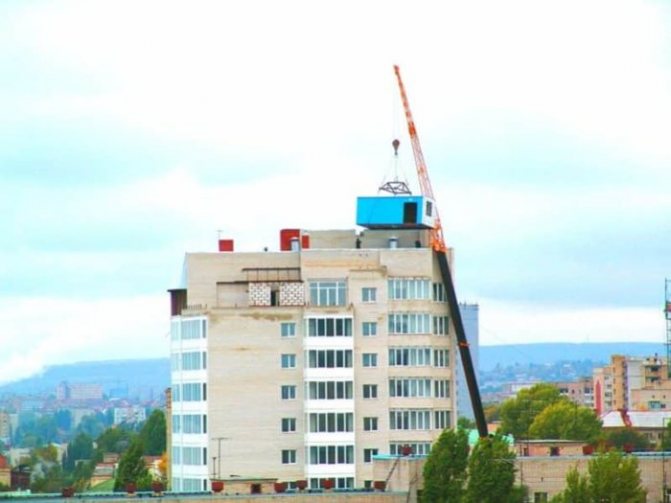

The main advantage of the device is the ease of creating and implementing a project. Along with the installation, work is being carried out to install sound-absorbing coatings and vibration protection. Carried out at the stage of finishing, they are more efficient in operation.
Block-modular
A block-modular type is used to accommodate a roof-top boiler room in the constructed building. The most common installation option is during a major overhaul. The roof boiler room is installed in case of restoration of the heating system. The project is created based on the characteristics of the building. Then the device is created and delivered to the required structure.
Before installation, a roof audit is carried out:
- Check the condition of the bearing supports.
- Apply a protective coating to the installation point. A concrete cushion acts as them.
- Installation of sound-absorbing material is carried out.
After completing the preparation, the boiler room is connected to the heating network. It is adjusted, the coolant is distributed. Having connected to the heating, they begin to operate.
What to look for
Before installing the device, you must take into account that it creates a load on the structure. Because of this, the following rules are required:
- It is forbidden to place the boiler room on the ceiling above the living quarters.
- It is forbidden to place the equipment in a room adjacent to a residential one.
- When designing, the size of the house in which the placement is planned is observed.
- When designing, an emergency shutdown system is created.


Alternative heating methods
Since water heating is expensive and complex, you can choose one of the available types of gas-fired appliances. To make the right choice, you must first study their technical description.
To heat a private house, you can use:
- Convectors. Only gas is supplied to them, and it is allowed to connect household cylinders.
- Infrared emitters. The products are suspended from the ceiling and work on the principle of solar radiation. With limited power, they can quickly heat up a large room.
When designing heating with gas, it should be borne in mind that this energy source is much cheaper than electricity, solid and liquid fuels.
Benefits
In order for the roof boiler room of a residential building to work stably, it is necessary to carry out careful calculations and not save on installation. Equipped on the roof of the house, it has advantages over other systems:
- Installed on the roof of the house, the boiler room reduces energy losses during the transfer of coolant from the rooftop equipment to the radiators. This reduces the cost of heating services by up to 30%.
- Automation serves the use of hot water during the absence, when the supply is turned off to check the media.
- Maintenance of the device is reduced due to autonomy. Functional check is carried out rarely, by agreement with the service company.
- Before operation, many checks are carried out to detect malfunctions and safety errors.
Selection and types of gas boilers
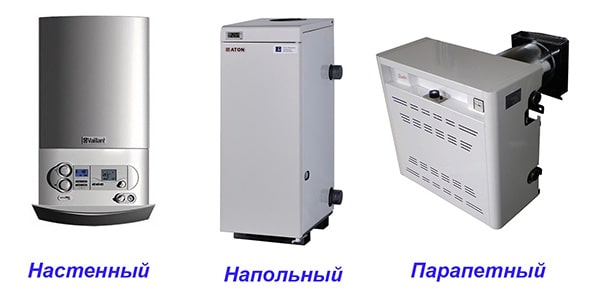

Modifications by installation method
Technology does not stand still, thanks to which many gas boilers with sets of functions that will suit any buyer have appeared on sale. Products differ in the criteria that are taken into account when arranging houses of all types, depending on their configuration and methods of fuel supply.
According to the degree of functionality, boilers are divided into the following types:
- Single-circuit. The heat carrier is used exclusively for space heating. It circulates in a closed circuit consisting of piping and radiators.
- Double-circuit. In devices of this type, two insulated heat exchangers are installed. One is intended for heating the house, and the second is for creating a supply of hot water in the boiler, which has wiring to the bathroom, outdoor shower and kitchen.
At the place of attachment:
- Wall mounted. They belong to the category of compact, they are chosen when the room is cramped or the interior conditions require it. In most cases, such devices are single-circuit, so they are hidden in niches or combined with cabinets of the same size. This achieves an organic environment without losing functionality.
- Outdoor. Products are more powerful, therefore weigh more. They need more space, and sometimes a separate room. As a rule, floor models are double-circuit, due to the consumption of a large volume of fuel, they require a direct vertical chimney. The structures are equipped with cast-iron heat exchangers, which makes it possible, in the absence of gas, to switch to solid and liquid fuels.
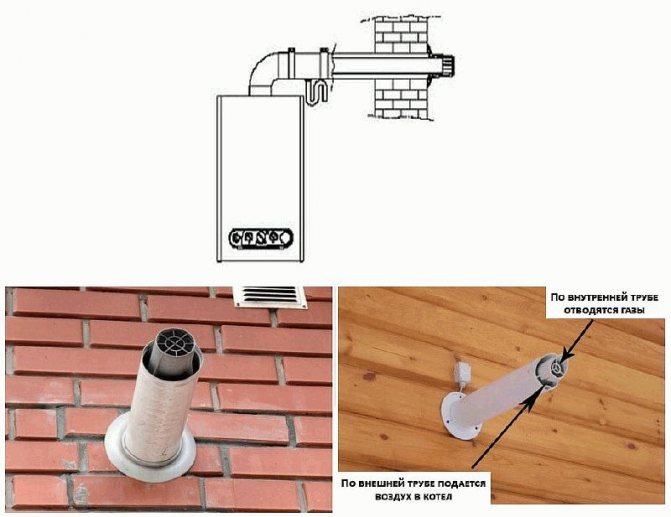

A turbocharged boiler is installed where there is no chimney and connection to it is impossible
By air intake options:
- Atmospheric. The combustion process takes place in an open chamber, air enters it directly from the room. The evolved gas is discharged through a plastic chimney into the street due to the difference in temperature and pressure. Due to the optimal composition of the mixture, the gas consumption is low, but the oxygen level drops, which negatively affects the well-being. In addition, in the absence of fresh air, the flame can go out. The room must be equipped with supply and exhaust ventilation.
- Turbocharged. This design with a closed combustion chamber, where air is pumped by a turbine from the street.Boilers with turbines are completely safe, they can be installed not only in the basement level, but also on residential floors. In wall-mounted devices, the combustion chambers are made of copper, and in floor-mounted devices, they are made of cast iron. These materials are more resistant to fire than steel and enable high power development. Double-circuit designs have a summer mode of operation, when only water for domestic purposes is heated.
When choosing an installation for heating a building, you should pay attention to the possibility of its disassembly and maintenance with your own hands. The bottom line is that heat exchangers need regular cleaning and flushing. The services of specialists are expensive, it makes sense to save on them.
Varieties of decentralized heat supply
Of course, building a stand-alone boiler room, even a small one, is quite expensive. And the attic option is also not cheap. However, there is an alternative.
Modular boiler rooms


Block-modular boiler room
One of the very interesting projects is modular, or block, boiler rooms. There is no need to build anything, and only a small site is allocated for the boiler room. Blocks are brought here, which are easily and quickly combined into a finished structure.
All of them are completed at the factory, the equipment inside them is precisely matched to technical indicators, they are insulated and have a presentable appearance. The most important thing is to properly arrange and connect the equipment. A couple of days and the boiler room is ready
But only specialists should be engaged in its assembly. If anyone remembers, such modular boiler rooms were used to heat change houses and barracks, that is, temporary structures. After engineers and designers worked on them, such autonomous installations began to be used for organizing heating in apartment buildings. However, this option is not the only one.
Wall mounted boilers
The most effective and economical today is apartment heating, where wall-mounted boilers are used as a heating device. They run either on gas or electricity. Why wall-mounted?
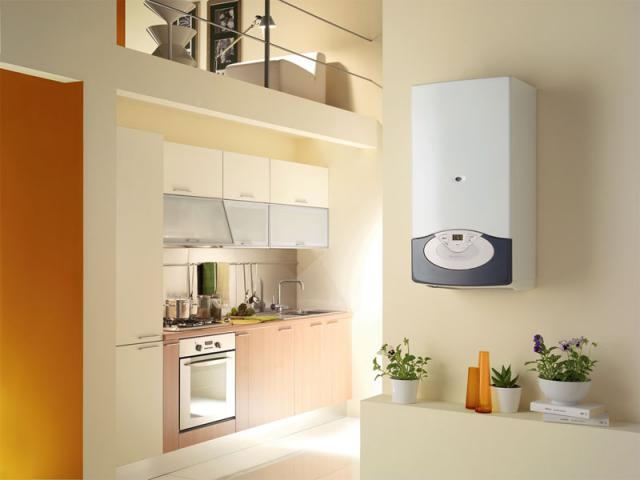

Wall mounted boiler
- Firstly, they are small in size so that they can be installed even in kitchens. Moreover, their appearance does not spoil the interior design at all.
- Secondly, wall-mounted heating boilers are real mini-boiler rooms. Their design includes a circulation pump, an expansion tank, as well as control and safety devices.
- Thirdly, such heating installations can have a power of up to 35 kilowatts, which allows them to heat rooms up to 100 square meters.
- Fourthly, modern manufacturers offer both single-circuit and double-circuit boilers for autonomous heating. So you will also be provided with hot water.
And now an important question - how to choose the right boiler? The main thing is to correctly select the unit according to its design features. It should contain all, without exception, the devices that we mentioned - a pump, a tank and so on. In addition, the presence of a chimney is mandatory, which will ensure not only the removal of fuel combustion products in the case of gas boilers, but also the inflow of clean air from the outside. This means that a wall-mounted gas boiler must be with a closed combustion chamber. And the last - full automation, which will not only simplify the operation of the boiler, but also save on fuel.
Of course, there are more connection problems with gas boilers. But electric counterparts in this regard are simpler. Here it is only necessary to lead a branch from the switchboard with the installation of the machine and connect to the water supply system.
What can be difficult?
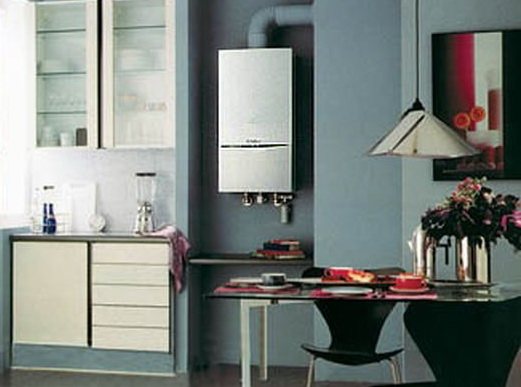

Modern kitchen
It may seem that everything is very simple and beneficial. Then why aren't tenants switching to this heating system? And nobody gives them permission.Imagine that the tenants of one house will immediately apply for the re-equipment of heating networks, or rather, for the refusal of the services of organizations that supply heat to houses. This is, firstly, a disaster for such an organization and the deprivation of its profits. And, secondly, job cuts, although this issue is controversial. Someone also needs to maintain autonomous mini-boiler rooms. So, in many respects, any of these options is not beneficial for management companies. Although on a national scale, the opposite is true. But this issue is not for us to decide.
What does the user get?
General positives:
- The consumer himself keeps records and controls the level of heating of water and premises. There are no interruptions, warm water all year round, heating can be turned on at any time.
- The apartment heating system allows you to save gas, but at the same time maintain the desired heat indicator. In addition, it becomes possible to reduce the numbers in the payment receipts. And today it is these indicators for each person that are of great importance.
- It is easier to build an apartment building with individual apartment heating, because there is no need to crash into the central pipe, obtain permission and pull a new highway. In the presence of a stable gas supply, construction takes place in any, even the most remote, territories. The payback of such a structure is fast. All developers are guided by this, as they also manage to save a decent amount.
- Apartment gas heating is an environmentally friendly solution that is chosen by many. Boilers with a closed combustion chamber are installed in apartments, so there is no need to install additional ventilation. The work of such an installation takes place independently, since everything you need is inside. Combustion products are immediately released outside and dispersed, while modern installations are designed according to all acceptable criteria and safety for the environment.
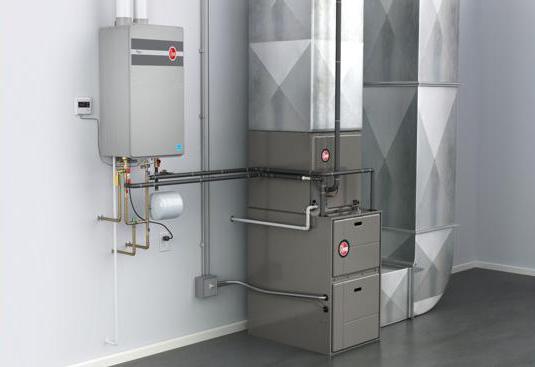

Autonomous heating in an apartment building
Is it possible to install autonomous heating in an apartment with your own hands? Although there is no legal ban on autonomous heating, it is still advisable to consult a lawyer, since some heating systems are prohibited. For example, water heated floors in apartments cannot be installed due to the fact that they can overload the system, thus depriving other residents of the house of heat.
In other cases, it is required to collect the necessary documents and submit them to local authorities:
- registration certificate for housing;
- a statement about the refusal of central heating;
- title deed;
- a diagram of a new heating system;
- the consent of all tenants of the apartment.
As a rule, such a seemingly simple request, such as giving up central heating and switching to heating itself, turns out to be a long-term bureaucratic problem.
Installation of autonomous heating in an apartment without the appropriate permission will become even more troublesome. This can end not only with a large fine, but also with legal proceedings, so before deciding to equip an apartment with any heating systems, you need to get advice from the relevant authorities and a permit for autonomous heating in the apartment.
Autonomous heating schemes for an apartment:
Advantages and disadvantages
If a permit has already been obtained for autonomous heating in an apartment building, then you can start choosing an alternative type of heat. It is easier to do this knowing the pros and cons of autonomous heating in the apartment.
For the first time, an autonomous heating system for an apartment appeared in Europe. Due to its clear advantages over centralized methods of space heating, it quickly spread throughout the world.
- The main advantage of the system is the significant cost savings.The owner of the apartment independently decides when to turn on and when to turn off the heating. For example, today there are thermostats in which you can set a timer for a specific time, which allows you to either completely or partially turn off the system when there is no one at home, and turn it on half an hour before the arrival of residents.
- The owner of the apartment can create the desired microclimate in each room.
- Pay exclusively for the heating meter and not depend on utilities and government tariffs.
When making a choice in favor of alternative heat, you need to know in advance how much autonomous heating costs in an apartment, and what kind of heating it will be not only economical, but also effective.
Among the disadvantages of such a system, the following nuances can be noted:
- Its regular preventive check once a year, for which you need to call a specialist. It's not that expensive, but still, many users either ignore this need, or simply forget about it.
- Installing even the best heating radiators for an apartment. you should be aware of possible heat loss. which are often caused by external walls, unheated from the bottom of the room or poor quality glazing.
Today, many construction organizations are building residential apartment buildings with ready-made autonomous heating systems. Such housing is in great demand, as it costs a little less and allows the owners to independently decide which type of heating to choose.
Determining the equipment home
Central heating in a private house
|
| Central heating in a private house |
When connecting a house to a central system, you will have to choose from three possible schemes: independent, elevator, dependent direct-flow. They differ in the equipment used.
- An independent scheme is chosen when it is necessary to avoid pressure surges in the system due to the design features of the house. If the system is made of plastic pipes, this must be shown. You will need a circulation pump - it helps to reduce resource costs and lightens the load on equipment. And you need an expansion tank. It compensates for overpressure when the heating medium (water) expands during heating.
- The second scheme: the elevator unit helps to adapt the hot water of the central network, where the standard is up to 150 degrees, to the standard of the house system - around 90 degrees. The water in the storage compartment of the house is mixed with the superheated water of the central system. The elevator has 3 functions: pump, hot water flow and temperature regulator, mixer. This way of organizing heating is popular.
- The direct-flow dependent system is simple in design, operation and maintenance. There is only a central boiler room, piping and radiators. No more equipment. Plastic pipes and aluminum radiators are prohibited due to high pressure and pressure drops.
Central heating in an apartment building
|
| Central heating in an apartment building |
In apartment buildings, central heating does not require special equipment. But still, there are rules. Heating is done according to four schemes:
- One-pipe works in Stalin's and Khrushchev's houses. There is one highway, both supply and return passes through it. Minus in large heat losses with distance from the heat source. This can be prevented by increasing the number of sections along the movement of water in the pipes. This circuit will not be able to regulate the temperature. If there is a desire to change radiators, then you cannot change to radiators of another design. This leads to disturbances in the operation of the heating.
- "Leningradka" is an advanced analogue of the one-pipe scheme. The bypass regulates the supply of heat carrier (water or steam) in the system. Bypass - a jumper of the pipe that connects the direct connection of the radiator with the return one. When looking at the radiator, it is a thin pipe connecting the upper and lower level of pipes in front of the radiator.
- The two-pipe system works on the principle of separating the supply and return lines. With this scheme, it is possible to change radiators within the recommended models and put adjusters to control parameters, even automatic ones.
- The beam scheme is installed in new buildings of a special type. The devices are connected in parallel and they do not affect each other. It is possible to control the level of heat supply. A configuration can be designed within the apartment.
Working pressure in the central system is from 8 to 10 atmospheres. And at the time of pressure testing - from 12 to 14. Therefore, PVC pipes are not suitable. Aluminum radiators will also not withstand such loads. Better to take steel, bimetallic or cast iron. Too lightweight radiators are a sign of poor quality. It is better not to save money here.
Autonomous heating in a private house
We offer you to familiarize yourself with: How to make a bath on wheels with your own hands
If there is no alternative to central heating, and engineering communications are not planned nearby, then autonomy is inevitable. What does an autonomous home system consist of? This is a device for heating, pipelines and shut-off valves.
The choice of equipment for a private house begins with the definition of the boiler. What are the boilers:
- Solid fuel - fuel is wood, coal, pellets. They take the second place in terms of efficiency after gas. But the exploitation process is laborious. Pros: Easy to reach, quick to ignite. Cons: low efficiency - 70%, frequent cleaning from combustion products, soot in the boiler room. You will need a warehouse for fuel, it needs to be loaded frequently. It is also important to consider the draft regulator. In order not to overheat the parts in the absence of electricity, they design a chimney. Suitable as a backup or auxiliary heat source: warm up the house to the required temperature, and then turn on the electric boiler to maintain it.
|
| Solid fuel boiler |
- Diesel boilers - usually floor-standing, have a spent fuel ejection device. When connected, provide a container for storing liquid fuel. The tank is installed indoors, or buried in the ground. The minimum volume is 750 liters. There is winter and summer diesel fuel. It is serviced once every 12 months: filters are changed, nozzles are cleaned. Pros: affordable cost, you adjust the temperature at will, the system is automatic. Cons: noisy during operation, expensive diesel fuel, fire hazard, fuel storage is problematic, boiler maintenance is laborious.

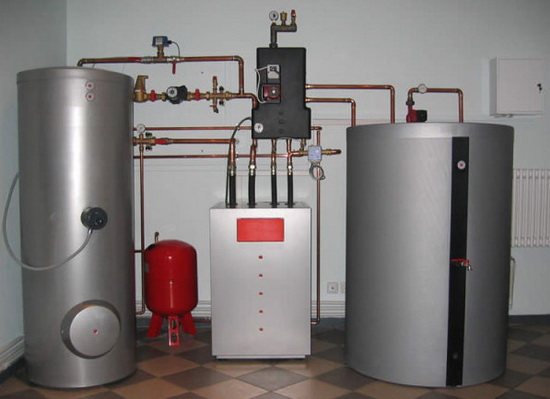
Diesel boiler - Gas boilers are the most popular. 5 times cheaper than liquid fuel and 3 times more economical than electric. There are wall and floor ones. Floor standing durable. They heat any area and often do not depend on electricity. When installing a wall-mounted boiler, the additional equipment is minimal. They do not take up space, they are easy to manage. There are single-circuit ones - they only heat. There are double-circuit ones - for both heat and hot water supply. But if the house has more than two water intake points and more than 2 family members, then a heating boiler from 75 to 600 liters is needed. There are models with a built-in boiler. It is better to buy a 1-circuit boiler for a summer home. For the winter, an anti-freeze liquid is poured into it. In double-circuit models, it is inconvenient to drain the liquid before winter, the residues can freeze and damage the devices. Gas boilers operate on mains and liquefied gas. In winter, the LPG cylinder must be changed frequently. If there is main gas, then there are no shortcomings. You can choose the power according to the formula: 1 kilowatt (kW) per 10 m2.
|
| Gas boiler |
- Electric boilers are the cheapest installation and equipment, but the most expensive fuel. If there is no gas, then the best form of heating. Eco-friendly, no harmful emissions, high efficiency, no need to build a separate boiler room and chimney. Before purchasing equipment, it is better to clarify how much power can be used to determine the load.Electric boilers are silent, there is no maintenance, the temperature can be controlled automatically. Cons: expensive resource, electrical dependence, do not work well when power drops.
|
| Electric boiler with expansion tank and circulation pump |
It is better to prepare a separate place or room for the boiler. If there is enough space, then choose a floor-standing boiler. If there is no extra space, then a mounted boiler will do.
It is better to design a heating scheme for a private house already at the construction stage. Having a scheme for placing pipes around the house, it will be possible to leave holes for them in advance. With a house area of 200 m or more, it is better to choose a boiler with two system circuits. You will also need an expansion tank and a heating circulation pump.
Autonomous heating in an apartment building
|
| Autonomous heating in the apartment |
It is difficult, but possible, to abandon central heating and switch to autonomous heating. It is illegal to change heating communications without permission. Utilities are reluctant to part with payers. For this, it is necessary to obtain a decision to disconnect from the central system through the court. First, you need to clarify in the housing and communal services, whether it is possible to implement this.
To switch to autonomous heating of an apartment, you need:
- Buy a circulation pump and install a heat exchanger. It is hung on the wall above the radiator line;
- Select and install the boiler. It is important not to save on equipment, to give preference to models with a safety system and with a closed combustion chamber. Take into account the pressure and temperature of the water in the system;
- The scheme is determined based on the layout. Often preference is given to Leningrad: a one-pipe scheme with parallel placement of radiators.
When switching to an autonomous heating system, any non-agreed procedure can lead to a loss of heat from neighbors.
